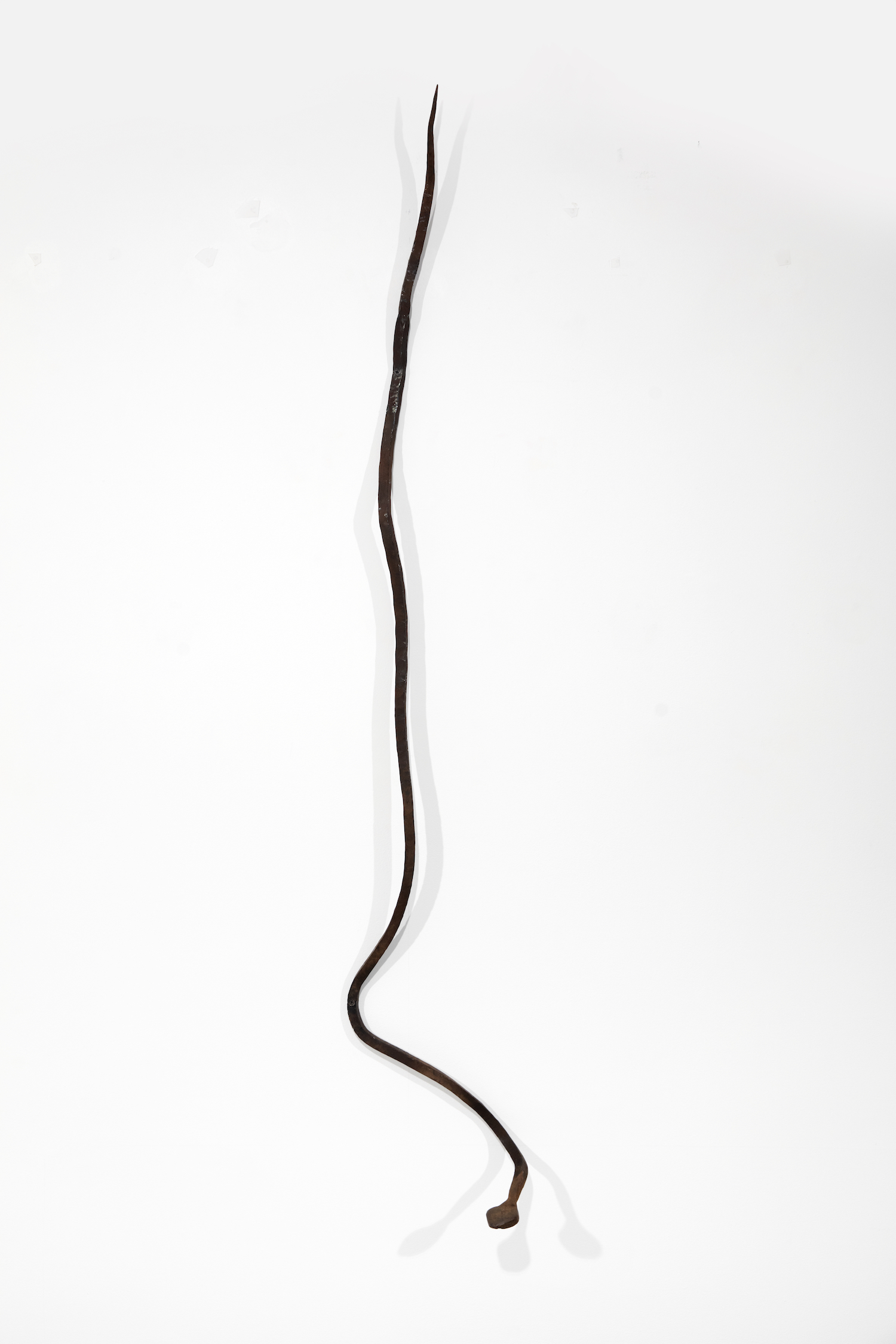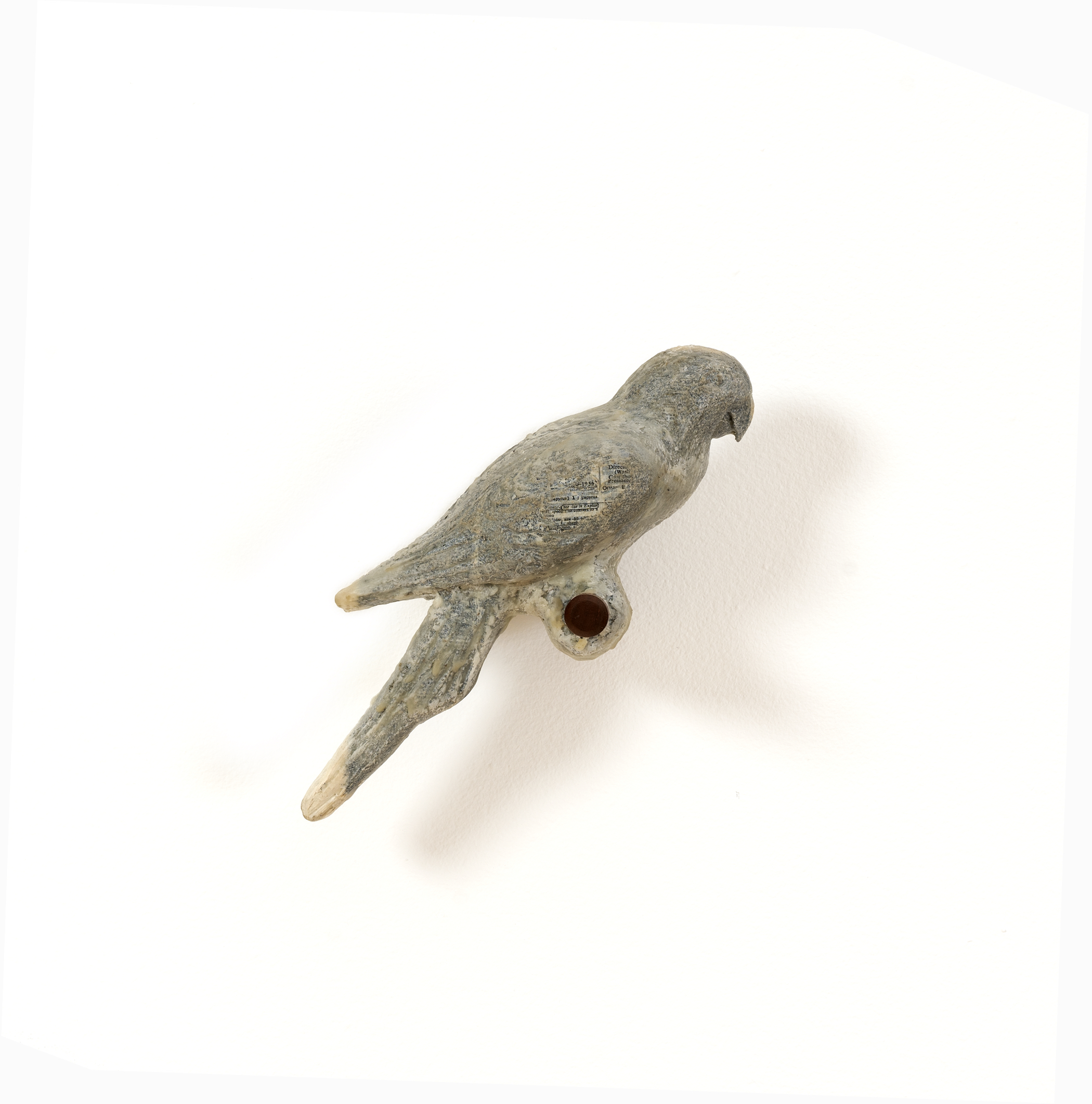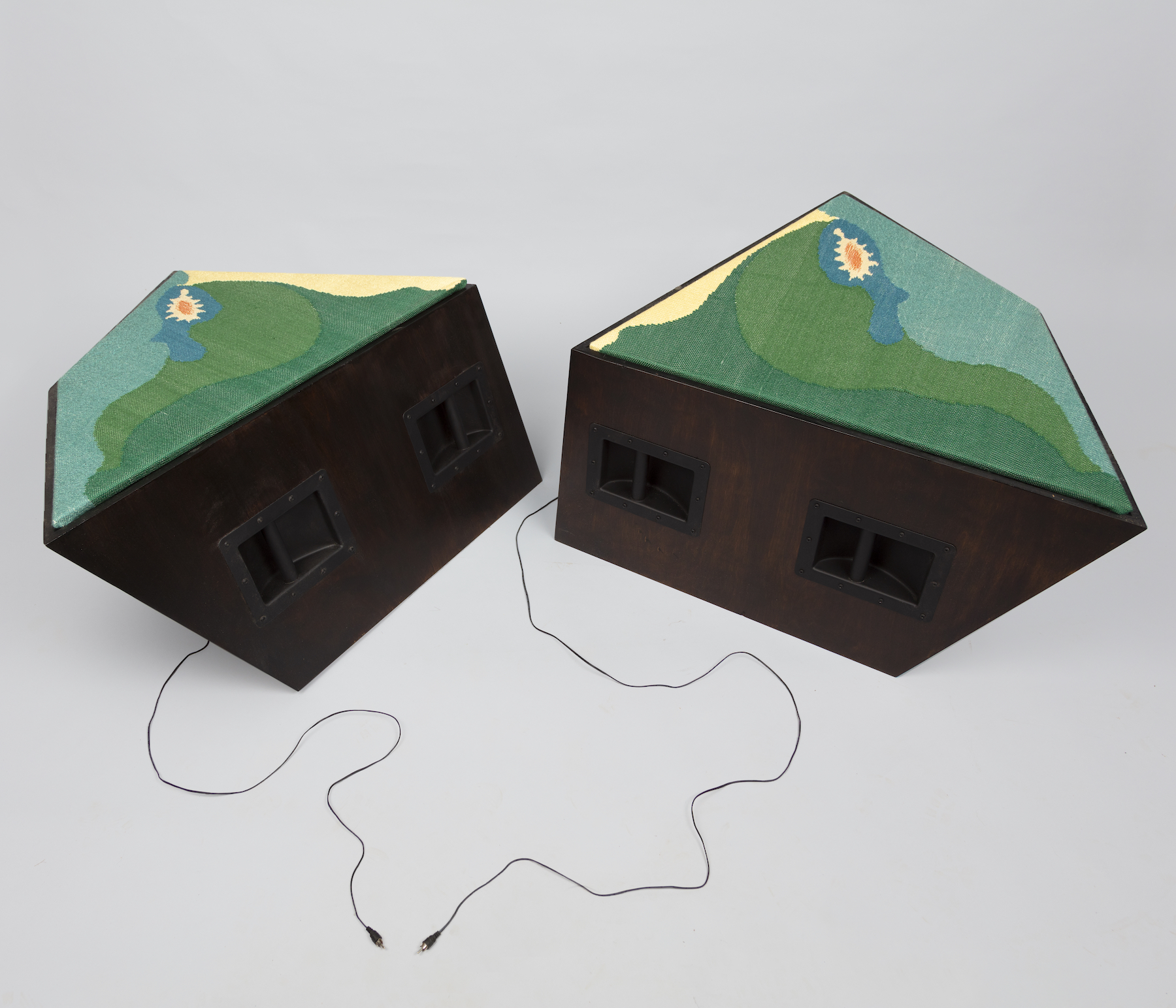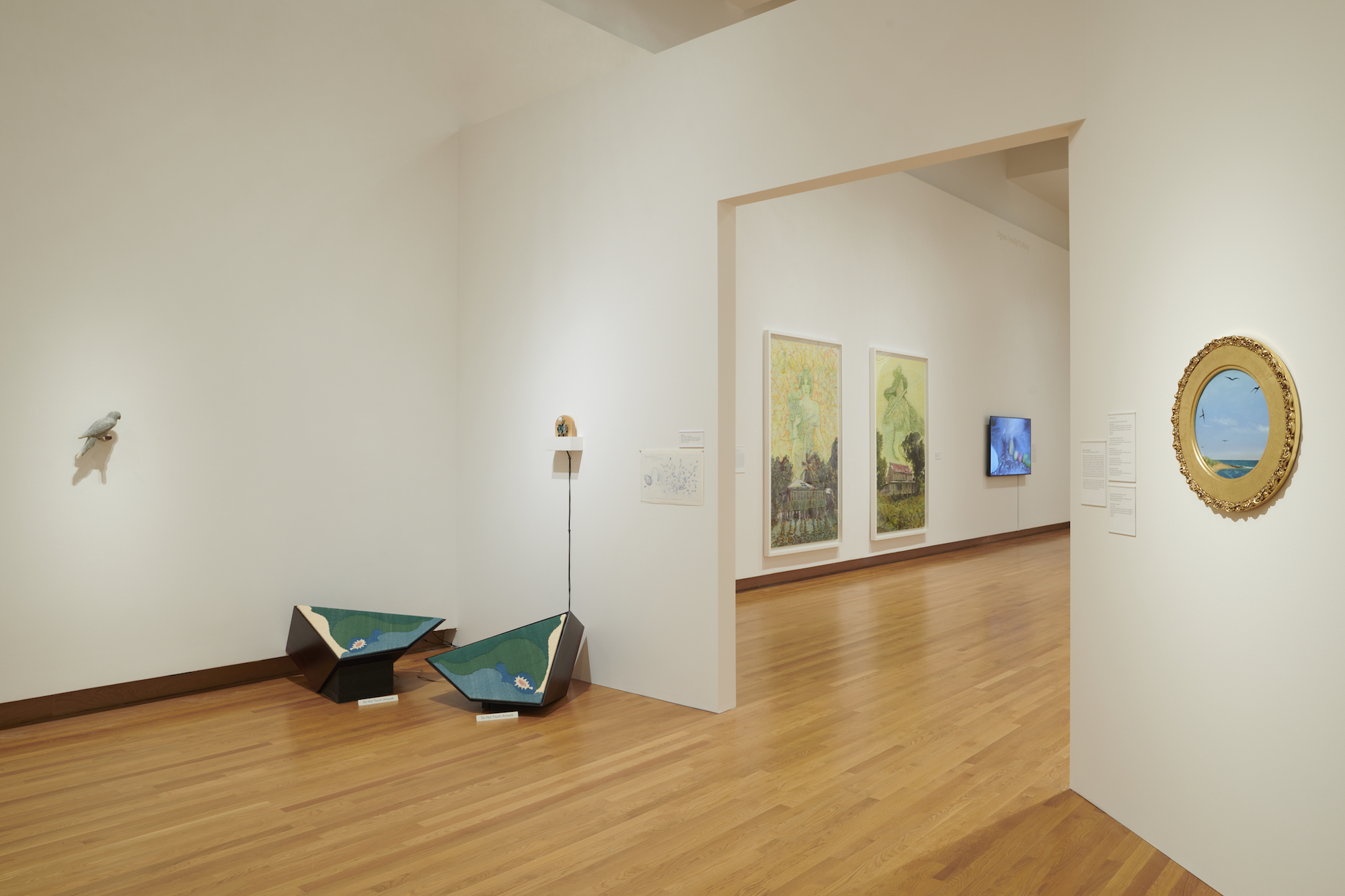Ecologies of Song
November 9, 2023
In this essay, doctoral candidate Thea Ballard takes up the mission of the Forum to bring programs at Duke into conversation with programs in the surrounding community, exploring the Nasher’s recent exhibit, “Spirit in the Land,” and Black Belt Eagle Scout’s performance at the Pinhook in downtown Durham.
By Thea Ballard, Doctoral Candidate, Duke University Department of Art, Art History & Visual Studies
Song Complicates the Visual Narrative
After my second visit to the Nasher exhibition “Spirit in the Land," which closed July 9, my boyfriend and I walked in the early summer heat towards the cultivated oasis of the Duke Gardens, and he pointed out an ant on the sidewalk carrying what appeared to be an entire Hot Cheeto. This image has stuck with me as much as any of those offered by the works on view, I suppose for its comic impurity, an unruly companion to the show’s theme.
The curatorial narrative for “Spirit in the Land” proposed that “our [human] identities and natural environments are intertwined,” invoking the problem of the division between nature and culture; it seemed to maintain a position that the “natural” world is a realm distinct from the “cultural” or human, even as the two remain in a hopeless tangle, knotted together by industrial crisis. The text offered that the artworks on view “reflect the restorative potential of our connection to nature and exemplify how essential both biodiversity and cultural diversity are to our survival.” Artists act as “environmental stewards” of this resource, making possible a more harmonious future. Nature was framed as a moral resource on which we might draw, through art-making, to variously connect, heal, or better ourselves, an idea some of the artworks themselves, depicting poisons and viruses, seem to counter.

Radcliffe Bailey, King Snake, 2021. Steel, 66 x 11 x 7 1/2 inches (167.6 x 27.9 x 19.1 cm). The Long Gallery Harlem Collection. © Radcliffe Bailey. Courtesy of the artist and Jack Shainman Gallery, New York.
In terms of place, time, and medium, “Spirit in the Land” staked its thematic claims broadly, though its most successful throughline grouped artists from the American South, gesturing towards solidarities between Black and Indigenous artists within that geographic space. As I sought particular aesthetic strategies within the show’s broad swath, I was struck by how song animated a few of the artworks to which I was drawn. Take, for example, King Snake (2021), by Radcliffe Bailey, which jutted its head out from the wall of the first gallery, where it was affixed vertically by a few screws as if slithering down from the ceiling, casting multiple slim shadows. The sculpture is crafted from found steel and railroad spikes, and shares its name with both a type of snake that inhabits Bailey’s land in Atlanta, and “Crawlin’ King Snake,” a Delta blues song made famous by John Lee Hooker and adapted by many, including the Doors and the Black Keys. Considerably less ornate than the works between which it crawled, King Snake is charged, the nexus of so many things that sometimes seem opposed—music, snakes, place, history, industry, nature, labor, art—welded into a wiry, lithe form.
Or, in a less compact but similarly expansive example, a selection of works by Mel Chin filled a corner, bringing together recorded sound, sculptural objects, image, and text to, among other ends, memorialize extinct birds. Among the objects on view were a Carolina parakeet carved from found wood and adorned with cuttings from an old edition of Webster’s Dictionary, trapezoidal speakers covered with decorative weavings, as well as materials—two poems and a hand-drawn diagram affixed to the wall—explaining the contours of the larger projects from which these fragments are drawn.


Here, the idea of song arrived threaded through both human and non-human sources, the former in Chin’s lyrical eulogy to the parakeet and the latter in recordings of extinct birds that play from the speaker contraption set on the floor. Ultimately, and somewhat ironically, it is technology that makes these songs available to us, that brings us closer to these lost species: the written word and the ability to record and play back sound.

Song as Technology
While song as a method or a medium doesn’t resolve the nature-culture problematic introduced in the curatorial text, it might provide an opening to complicate the stated aims of "Spirit of the Land." There is something to be said about the ways the form is deployed to produce a multivalent sense of place, across various cultural contexts and genres. Song is often ecological, and it can be so across genres, and at varying degrees of proximity to culture (and the culture industry). In and out of the exhibition, the form allows for a kind of thinking and feeling about our environs that operates beyond the scope of the exhibition's call for artistic stewardship.
We might think of song as itself a technology of navigation in both space and time. Thomas F. Thornton, Mary Rudolph, William Geiger, and Amy Starbard, in their article “A Song Remembered in Place: Tlingit Composer Mary Sheakley (Loo) and Huna Tlingits in Glacier Bay National Park, Alaska,” argue for the ethnobiological valences of Tlingit song, alongside its established social and emotional context. They focus on a recording from the late 1990s of Tlingit elder Amy Marvin singing a song composed by her deceased relative Mary Sheakley, during a visit to pick berries in Glacier Bay National Park’s Dundas Bay; the song is performed as a memorial to relatives deceased in a boating accident, but was written in response to howling wolves encountered while picking berries many years before. Various forms of commemoration intermingle with communication with non-human entities, tracing and then—through oral exchange and performance—layering a particular time and place to ends both expressive and instructive. Marvin’s practice involves the memory and repetition of song, each of which contribute to the medium’s stickiness: its ability to help us carry around people and places.
Song need not invoke a specific concept of nature to be ecological: for one example among many, take how contemporary American country music navigates the South’s post/industrial space. Alan Jackson’s 1992 classic “Chattahoochee,” a nostalgic and relentlessly upbeat party song, makes particular a late modern Southern coming-of-age on the banks of the river for which it is titled (first named by the Creek): an image of “muddy water” streaked with steaming asphalt and artificial grape flavoring. At one point in its music video, which opens and closes with oversaturated images of Jackson and his bleached mullet gleefully waterskiing, a group of young men encounter a turtle crossing a riverside road; they stop their car and get out to feed it bites of a fast-food hamburger.
Song need not invoke a specific concept of nature to be ecological.
Country loves to make maps and metaphors of roads, from “Goin’ Down the Road Feelin’ Bad” to the lost love of Charley Pride’s “Is Anybody Goin’ to San Antone” and the anthemic nationalist pseudogeography of Jimmie Allen and Brad Paisley’s “Freedom Was A Highway.” The title track of Lucinda Williams’ 1998 album “Car Wheels on a Gravel Road” sets up a child’s backseat journey west from Macon, GA, to Jackson, MS, accompanied by the voices of Loretta Lynn and Hank Williams on the car radio. From the road—on a trip intimated to be taken out of desperation—the ~450 mile stretch of land appears as “cotton fields stretching miles and miles,” where “telephone poles, trees, and wires fly by.” Williams and Jackson in particular render intimate landscapes remade by human industry, establishing an emotional, if not significantly ethical, set of relations to these complex, transfigured environments.
Land, Water, Sky
The music of Katherine Paul, whose band, Black Belt Eagle Scout, toured through Durham during the run of “Spirit in the Land,” emphasizes and extends the emotional relationship to place that is present in so many forms of songwriting. If “Spirit in the Land” proposed nature as a moral resource, Paul’s resolutely ecological songs draw on concepts of land and place as something like a relational one. Paul is Swinomish/Iñupiaq, and grew up on Swinomish Indian Tribal Community land on the Puget Sound in Washington; she now lives in Portland, OR, but her band’s most recent album The Land, The Water, The Sky narrates a return to the place she grew up during the lockdown of 2020.
If “Spirit in the Land” proposed nature as a moral resource, Paul’s resolutely ecological songs draw on concepts of land and place as something like a relational one.
The record uses the familiar shape of the indie-rock song—as fine a form as any to process a homecoming—and injects it with the specificities of her family, her ancestral community, and the land she calls home. Paul’s vocals are a steady, expressive companion throughout the album’s twelve songs, somehow maintaining a constant register of intimacy, brushed with the tender quality of, say, hearing for the very first time someone you know and like sing out loud in front of you. Her lyrics are spare; she seems to trust her voice’s capacity to communicate experience and feeling outside of language.
In the cryptic world of her lyrics, as well as her directional song titles and vocal style, the land, water, and sky are active presences. They emerge within social experience, as in “On the River,” where a river and a lover’s lips are connected over lapping guitar: “I want it here/On the river/I want it here/Through your lips.” Places witness Paul as she witnesses them. Or they form song-worlds unto themselves, as in “Salmon Stinta,” in which an image of Paul viewing this place through the conflicted remove of a window is framed by salmon swimming upstream, the sound of rippling water evoked by a chorus of gentle “bah-bah”s. (On that song, she is joined by mentor Phil Elverum, of Mount Eerie and the Microphones, whose own devastating Pacific Northwestern songwriting I have previously written about in the context of its ecological tendencies.) Here, the invocation of two places—the movement of water and the stillness of a domestic interior—is not meant to make a metaphor of one or the other, but to describe as connected multiple states of being alive.
There was something striking about seeing these songs performed live at the Pinhook, given how directly they conjure somewhere specific and far away. The Pinhook, like the temporary exhibition space at the Nasher, is for me and other locals a familiar location unto itself, but both are also non-spaces meant to be filled in for our engagement by transitory visitors, who, whether touring band or artwork on loan, are for the time being far from home. The distance between places, itself a form of relation, felt tangible, perhaps all the more so because for a brief time Paul’s vivid songs built her landscape of land, water, and sky within the venue.
The band was passing through town on an almost-uncomfortably-warm late spring day, and they asked the crowd where they might go swimming the next morning before driving on to their next stop. Turtle Hole was the consensus, an image of nature and culture’s collision if there ever was one: I wasn’t there the day they went, but can conjure quickly a high-summer image of the bathwater-warm pond on the Eno in a palette of dirt neutrals and swimsuit neon, young people flinging themselves from a spindly tree to the center of the water, where turtles’ heads poke above water between drifting plastic inflatables.
View this post on Instagram
On a weekday afternoon in late July, another week of record-breaking summer heat, I went out to Turtle Hole. Ants swarmed my totebag the moment I placed it down. I swam with my friend Karly, and with some small fish gathering at our toes, and with a slice of watermelon bobbing at the water’s center, and with the odd abandoned lighter or beverage container adorning the shoreline. When I put my head back and floated, gently wavering treetops made a neat circle around a nearly cloudless sky. Not quite a solution to the sense of crisis I felt as the sun singed my skin at the water’s edge, but maybe a song in the making.
***
 Thea Ballard is a writer and doctoral candidate in Art, Art History & Visual Studies at Duke University studying sound and performance in American contemporary art. Her dissertation explores uses of conversational voice in artworks by Robert Ashley, Wynne Greenwood, and Wu Tsang and Fred Moten. Her art and music criticism has appeared in publications including Artforum, Art in America, e-flux Criticism, Pitchfork, The Brooklyn Rail, Momus, ArtReview, The Nation, and Dis. She has contributed to exhibition catalogues for Israel Lund and John Akomfrah.
Thea Ballard is a writer and doctoral candidate in Art, Art History & Visual Studies at Duke University studying sound and performance in American contemporary art. Her dissertation explores uses of conversational voice in artworks by Robert Ashley, Wynne Greenwood, and Wu Tsang and Fred Moten. Her art and music criticism has appeared in publications including Artforum, Art in America, e-flux Criticism, Pitchfork, The Brooklyn Rail, Momus, ArtReview, The Nation, and Dis. She has contributed to exhibition catalogues for Israel Lund and John Akomfrah.
check us out
on social media